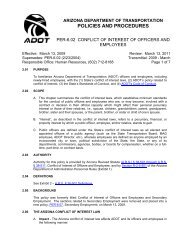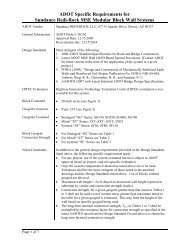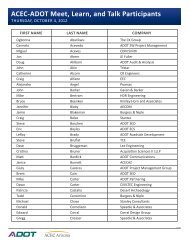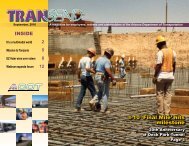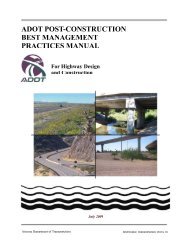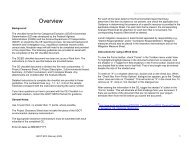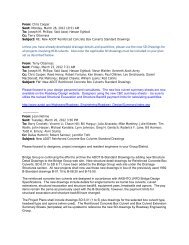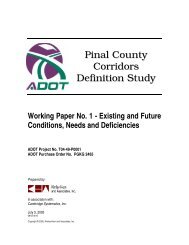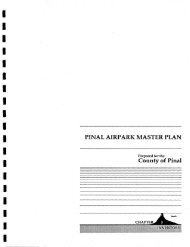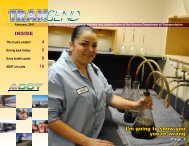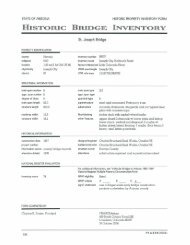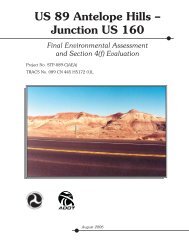I-10 Twin Peaks Traffic Interchange, Environmental Assessment
I-10 Twin Peaks Traffic Interchange, Environmental Assessment
I-10 Twin Peaks Traffic Interchange, Environmental Assessment
You also want an ePaper? Increase the reach of your titles
YUMPU automatically turns print PDFs into web optimized ePapers that Google loves.
Affected Environment and <strong>Environmental</strong> Impacts October 2005<br />
Preferred Alternative<br />
The preferred alternative would not impact the fulvous whistling duck. Potential<br />
suitable habitat for the duck in the study area is limited to a small, narrow band of<br />
riparian vegetation along the Santa Cruz River that lacks sufficient vegetation<br />
cover and density to support fulvous whistling duck nesting.<br />
Mitigation<br />
The preferred alternative would implement measures to minimize impacts to<br />
vegetation and restore any vegetation losses resulting from construction. The<br />
fulvous whistling duck would benefit from the mitigation measures outlined in the<br />
revegetation plan developed for this project.<br />
Conclusion<br />
Fulvous whistling duck are documented to occur within two miles of the project<br />
area; however, potential suitable habitat in the study area is limited to a small,<br />
narrow band of riparian vegetation along the Santa Cruz River that lacks sufficient<br />
vegetation cover and density to support fulvous whistling duck nesting.<br />
Plants<br />
Threatened/Endangered Species<br />
Species<br />
For purposes of this assessment, federally listed plant species include endangered,<br />
threatened, proposed, or candidate species as defined in the ESA. The list of<br />
federal species used in this report was developed from the federally listed,<br />
proposed, and candidate species for Pima County from the USFWS Arizona<br />
Ecological Field Office website. The species list contains 4 endangered and 1<br />
candidate species (Table 4-4).<br />
No federally listed plant species occur in the project area because the project area<br />
is either: 1) clearly outside of the known geographic or elevational range of the<br />
species; or, 2) does not contain habitat characteristics known to support the<br />
species.<br />
Common Name<br />
Table 4-4. Special Status Plant Species<br />
Scientific Name Status<br />
Huachuca Water Umbel Lilaeopsis schaffneriana spp. recurva Endangered<br />
Kearney Blue Star Amsonia kearneyana Endangered<br />
Nichol’s Turk’s Head Cactus Echinocactus horizonthalonius var. Endangered<br />
nicholii<br />
Pima Pineapple Cactus Coryphantha scheeri var. robustispina Endangered<br />
Acuna cactus Echinomastus erectocentrus var. acunensis Candidate<br />
Interstate <strong>10</strong> <strong>Traffic</strong> <strong>Interchange</strong> at<br />
<strong>Twin</strong> <strong>Peaks</strong>/Linda Vista<br />
4-34<br />
Project No.: NH-0<strong>10</strong>-D (AIW)<br />
TRACS No.: <strong>10</strong> PM 236 H5838 01D



